#Kevin McCarney
Text
Finding Neutral with Kevin McCarney
Finding Neutral with Kevin McCarney
Kevin McCarney is a successful entrepreneur, owner of the restaurant chain, Poquito Mas, public speaker, and mentor. He’s also the author of Big Brain Little Brain. Kevin has managed to flip neuroscience into easy to digest language. You can learn about:
Neurological responses in our big brain and little brain.What the Little Brain Activators and Big Brain Boosters are and how we could use…

View On WordPress
#Best Podcast for Leaders#best_leadership_podcast#Big Brain Little Brain#Kevin McCarney#Leadership#Leadership Hacker#Leadership Podcast#Podcast#Steve Rush#The leading leadership podcast#trending_leadership_podcast
0 notes
Text
Moonlight
The 2016 film, Moonlight, which is loosely based on the life of Tarell Alvin McCarney, focuses around themes of love, mother and father figures, finding one’s self, and coming of age. The film follows the life of a black man in Florida and is broken up into three parts that each represent different stages of the man’s life: childhood, adolescence, and adulthood.
The first part of the film focuses on the childhood of the boy, Chiron, who lives alone in Florida with his abusive, drug-addicted mother. The boy finds a father figure in a man named Juan, who takes offers to take Chiron home one day after finding him hiding from a group of bullies. As the film progresses it is revealed that Juan is a drug dealer in the community and is responsible for selling drugs to Chiron’s mother. It is at the end of this first part where it is first hinted that Chiron is gay.
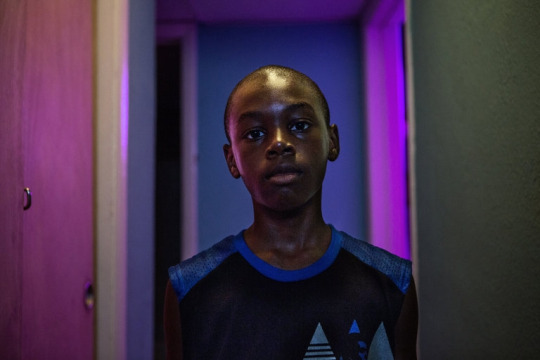
Photo. “Moonlight's Review.” Moonlight's Review, 2017, plymouthartscentre.org/moonlight-review/.
The second part focuses on Chiron’s teenage years where he struggles with bullies and coming to terms with his sexuality. He hides his sexuality from most members of the community in order to avoid ridicule but eventual reveals it to friend Kevin one night. The two proceed to kiss and engage in other sexual activities. The second part ends with Chiron getting arrested for assaulting a classmate after the classmate pressured Kevin into beating him up the day prior.

Photo. 2016. “Hidden Meanings Behind the Movie ‘Moonlight.’” Hidden Meanings Behind the Movie "Moonlight", Beyond 50, 2017, www.beyond50radio.com/Conscious_Movie_Reviews-Moonlight.html.
The final part centers around Chiron as an adult. Chiron who has now developed a hypermasculine physical appearance is now a drug dealer in Atlanta. He returns to Florida after a call from Kevin one day. The two meet, discuss how their lives have changed, and as the film ends with Chiron revealing that he hasn’t been with anyone since Kevin. The two embrace and the movie ends.

Photo. 2016. “Hidden Meanings Behind the Movie ‘Moonlight.’” Hidden Meanings Behind the Movie "Moonlight", Beyond 50, 2017, www.beyond50radio.com/Conscious_Movie_Reviews-Moonlight.html.
This film tackles the ideas of masculinity and power, particularly in an area where the people have very little privilege. McCarney describes the topic of black masculinity and how hyper masculinity among young black men is often more widely accepted among peers and society as a whole. This explains why the main character tries so hard though his teenage years to mask his sexual identity, because he is afraid of being seen as weak or powerless.
I see several parallels between this film and our readings. Themes of privilege come up a lot in this film and I found myself often reflecting back on McIntosh’s: Unpacking the Invisible Knapsack. I thought about how different this boy’s life would’ve been if he was white, or if he had been raised as predominantly white society. This is by NO means saying that white people who are a part of the LGBTQ+ community have it easy, but being black and living in such a toxically masculine society just added to the struggles this boy faced.
0 notes
Text
Maintaining at North Texas is hard, but Littrell’s doing just that
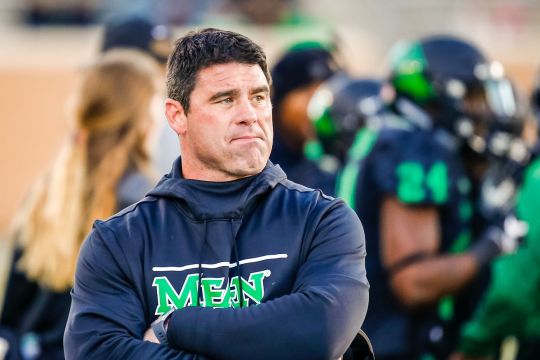
No one has jumped from North Texas to a power conference head coaching gig in nearly 40 years. With another strong year or two, Littrell will probably end that streak.
You can win in Denton, but you probably won’t win for long there.
When Darrell Dickey took over in 1998, it took him five years to produce a genuinely good team. He went to four straight New Orleans Bowls — the modern model for sustained success in Denton — but had already begun to slide. In his last two seasons, he went 5-18.
After Dickey’s replacement, Texas high school legend Todd Dodge, crashed and burned (UNT went 8-40 in his four seasons), it was up to Dan McCarney to pick up the pieces. It took him only three years to surge to 9-4, but he couldn’t maintain the success, and in his last two seasons, UNT went 5-19.
McCarney’s coaching career was basically over when he left Denton. Dodge was back in the high school ranks within a year or so of his departure. Dickey spent the last decade as a mid-major offensive coordinator or co-coordinator, which is what he was before UNT as well.
You have to go back nearly four decades to find a time when someone went from North Texas head coach to something bigger.
Jerry Moore went just 11-11 in 1979-80 but, combined with his success as a Tom Osborne assistant at Nebraska, managed to land the Texas Tech job in 1981. (He didn’t fare well there but, starting in 1989, became a coaching legend at Appalachian State.)
Hayden Fry played things perfectly. Fired after a 7-4 season at SMU, Fry rehabilitated in Denton. He won 33 games from 1975-78 and got UNT to as high as 16th in the coaches’ poll during a brilliant 1977. He parlayed this into two decades as Iowa head coach.
That Littrell took this job, then, was a bit of a risk. The draw is easy to describe — you’re barely 30 miles from Dallas (where hundreds of potential FBS prospects live), Apogee Stadium is nice and rather new, Denton has an In-N-Out Burger* — but evidence of success has been hard to come by.
Littrell has already thrived. After inheriting a 1-11 team, he has won 14 games, with two bowl bids and a division title, in his first two years.
He’s not blowing away the field from a recruiting perspective; per the 247Sports Composite, UNT’s signing classes ranked just eighth in C-USA in 2018 and 11th in 2017. But the former Oklahoma fullback and Mark Mangino, Mike Leach, and Kevin Wilson protege didn’t need long to begin establishing offensive success.
After averaging just 23.8 points per game in his first 10 games, the Mean Green have averaged 34.2 since. They were held under 29 points just three times in 14 games last year and topped 40 six times. And they did so with a sophomore throwing primarily to freshmen and sophomores. His offense actually has experience this year, which should be terrifying for C-USA defenses.
Granted, the defense could still use some work. The Mean Green had an average Def. S&P+ ranking of 109th in McCarney’s last two seasons and have improved only to an average of 96th. But with a top-30 offense, you can afford shootouts.
* That’s a draw for me, anyway, even if In-N-Out is no Shake Shack.
Offense

Littrell’s offensive success is also Graham Harrell’s success. The 32-year-old former Texas Tech quarterback came to Denton and figured out how to turn playing success into coaching success.
After a few years of backing up Aaron Rodgers in Green Bay, Harrell moved from Oklahoma State quality control coach to Washington State receivers coach (under Leach) to UNT OC. He could tell you all the ways in which his philosophy differs from that of Leach, but the footprint is similar: spread opponents out, throw more than the national average, and wreck opponents with efficiency.
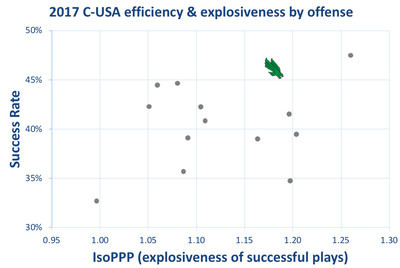
Within C-USA, only FAU had a more efficient offense than UNT’s, and that’s a staggering statement considering the personnel in the passing game. Turnover in the receiving corps is generally a harbinger of regression, and the Mean Green had to replace four of their top six WRs from 2016.
But with three sophomores leading the way (slot receiver Michael Lawrence and wideouts Rico Bussey Jr. and Jalen Guyton combined to catch 158 passes for 2,271 yards and 20 touchdowns), plus three other freshmen or sophomores catching at least 18 passes, North Texas improved from 122nd to 36th in Passing S&P+.
Lawrence is one of the best possession men in the country. Of the 92 FBS players targeted at least 85 times last year, his plus-24.5 percent marginal efficiency was the best.
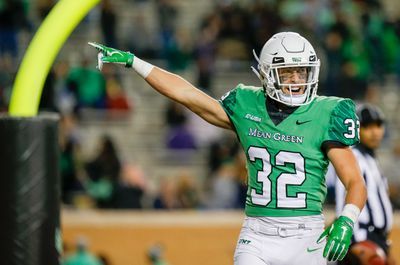
Ray Carlin-USA TODAY Sports
Michael Lawrence
A product of Sweetwater (Tex.), Lawrence walked on at UNT, and in 2017 he offered an efficiency outlet that hadn’t existed.
The run game helped. Harrell leaned on it at least a smidge more (UNT’s run rate increased from just 53 percent to 54 on standard downs but from 27 percent to 32 on passing downs) and was rewarded. Despite missing the last three games, Jeffery Wilson rushed for 1,215 yards. And in his absence, then-freshman Nic Smith held the fort, at least for a while. He rushed 26 times for 178 yards in a win over Rice but was limited to just 69 in 20 carries against FAU and Troy to finish.
Smith didn’t flash the same level of explosiveness as Wilson or fellow sophomore-to-be Evan Johnson, but it appears he’ll get the first crack at replacing Wilson all the same.
Running behind a line that returns four of last year’s starters and six guys with at least 11 career starts will help. Center Sosaia Mose, left guard Elex Woodworth, and left tackle Jordan Murray are all back from a line that improved dramatically, in both run blocking and pass protection.

Troy Taormina-USA TODAY Sports
Mason Fine (6) and Nic Smith (21)
If either Smith, Johnson, Anthony Wyche, or JUCO transfer DeAndre Torrey can do a Wilson impression, then UNT will have an outstanding base of efficiency for Fine, who has already thrown for more than 5,600 career yards. And when you’ve got that in your back pocket, you can take some shots. While Lawrence did a lot of the dirty work nearer the line, Bussey and Guyton averaged 15.1 yards per catch with above-average marginal efficiency and excellent marginal explosiveness.
That trio will account for a majority of UNT’s receptions if healthy, but there’s still a chance for sophomore slot and star return man Jaelon Darden, tight end Kelvin Smith, three-star redshirt freshman Greg White, or three-star true freshmen Jyaire Shorter or Austin Ogunmakin to carve out a role. This is a deep corps.
With two more years like 2017, Fine could finish with more than 13,000 career yards — not quite Harrell’s 15,793, but still top-20 all-time.
Defense

To his credit, coordinator Troy Reffett has indeed engineered improvement. An average Def. S&P+ ranking of 96.5 is better than what he inherited. But despite returning a chunk of his 2016 contributors, his Mean Green defense fell from 93rd to 100th last fall.
UNT vs. SMU, FAU (twice), Army, and Troy (1-4): 52.6 points per game | 7.9 yards per play | 11.4 percent average percentile performance (~top 115)
UNT vs. everyone else (8-1): 25.2 points per game | 4.8 yards per play | 63.2 percent average percentile performance (~top 50)
The Mean Green gave up nearly as many yards (2,926) in those five games as they did in the other nine (3,114). They handled other decent offenses (Iowa, Southern Miss) reasonably well but had no answers for SMU, FAU, Army, or Troy.
Will we see another step forward in 2018? It’s hard to guarantee it.
North Texas could start seven or eight seniors, which generally foretells improvement, but depth could be a major concern in the front seven, where Reffett is a couple of injuries away from dipping heavily into the 2017 or 2018 recruiting classes.
The line returns three of its top four tacklers (positive spin) but also loses four of its top seven (negative spin). After senior tackles Roderick Young and Ulaisi Tauaalo and junior end LaDarius Hamilton, the leading returning tackler is sophomore end Dion Novil, who had 2.5 last year.
Littrell signed two JUCO transfers (end Darrian McMillan and tackle Tuulau Saafi) to shore up depth a bit, and Kansas State transfer Bryce English could finally be ready to contribute after sitting out his first two years at UNT (one per transfer rules, the other because of a camp injury). But if they aren’t all ready to go, I’m not sure who will be.
The linebacking corps does bring back seniors E.J. Ejiya and Brandon Garner, who combined for 18.5 tackles for loss, nine sacks, and 18 percent of the team’s havoc plays in 2017. But with two other starters gone, sophomore Joe Ozougwu (who made five of his 13.5 tackles behind the line), JUCO transfer Tim Faison, and at least one youngster will need to step up. Redshirt freshman Kody Fulp has been a spring standout so far, but spring just began, obviously.
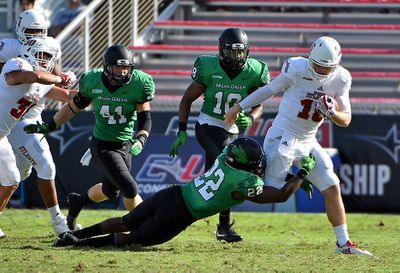
Jasen Vinlove-USA TODAY Sports
E.J. Ejiya (22)
If the front seven holds up, the secondary should be solid. UNT held opponents to a 55.1 percent completion rate (27th in FBS), albeit with quite a few big plays mixed in, and of the 10 DBs to record at least seven tackles last year, eight return. Corner Kemon Hall led the way from a havoc perspective (one TFL, one interception, eight breakups, one forced fumble), and nickel back Ashton Preston thrived near the line of scrimmage with 4.5 TFLs.
Littrell has signed 17 three-star athletes in the last two classes, and five of them have been defensive backs. If one or two crack the rotation, that could only be considered a good thing.

Ray Carlin-USA TODAY Sports
Kemon Hall
Special Teams
Special teams did UNT a lot of favors, and they mostly came from two guys. Kicker Trevor Moore not only made all of his PATs and under-40-yard field goals, but he made nine of 11 beyond 40 as well. As soon as they entered the opponent’s 30 or 35, the Mean Green were almost guaranteed at least three points.
Moore is gone, however, and could be replaced by Arkansas graduate transfer Cole Hedlund.
Jaelon Darden’s back, though. The slot receiver averaged 11.9 yards per punt return as a freshman, which could pay off handsomely if, you know, UNT forces a few more punts this year.
2018 outlook
2018 Schedule & Projection Factors
Date Opponent Proj. S&P+ Rk Proj. Margin Win Probability 1-Sep SMU 74 -0.2 50% 8-Sep Incarnate Word NR 42.2 99% 15-Sep at Arkansas 52 -9.9 28% 22-Sep at Liberty 115 5.7 63% 29-Sep Louisiana Tech 70 -0.7 48% 6-Nov at UTEP 130 14.2 79% 13-Oct Southern Miss 94 4.9 61% 20-Oct at UAB 91 -1.1 47% 27-Oct Rice 128 15.1 81% 10-Nov at Old Dominion 114 5.4 62% 17-Nov Florida Atlantic 31 -9.8 29% 24-Nov at UTSA 104 2.2 55%
Projected S&P+ Rk 86 Proj. Off. / Def. Rk 35 / 118 Projected wins 7.0 Five-Year S&P+ Rk -7.6 (102) 2- and 5-Year Recruiting Rk 99 / 106 2017 TO Margin / Adj. TO Margin* -11 / -8.6 2017 TO Luck/Game -0.9 Returning Production (Off. / Def.) 70% (80%, 59%) 2017 Second-order wins (difference) 7.8 (1.2)
Thanks to the thinned-out defense, S&P+ is only lukewarm on UNT in 2018. The offense is projected to again rank in the Off. S&P+ top 35 -- and it’s such a young unit that it will return almost everyone from that top-35 unit in 2019 as well. But it’s all about how many stops the Mean Green can make. For much of last season, that wasn’t a major issue. But when it was a problem, it was a crippling one.
The schedule features a lot of dead weight, which all but guarantees a third bowl trip in three years. UNT faces likely losses at Arkansas and against FAU but is given a 47 percent win probability or greater in each of the other 10 games, six of which are against teams projected 104th or worse.
Both the non-conference and conference portions of the schedule start with huge home tossups -- SMU in Week 1, then Louisiana Tech in Week 5. Win those two, and the Mean Green are potentially on their way toward double-digit wins in Littrell’s third season. Lose both, and coming anywhere close to last year’s success will be nearly impossible.
Either way, Littrell is in position to do something that hasn’t been done in Denton in nearly 40 years.
Team preview stats
All power conference preview data to date.
0 notes
Text
Promotion Watch ’19: KPMG Admits 138 New U.S. Partners
We’re about T-minus 30 days until KPMG releases its global revenue for fiscal year 2019. In the meantime, we got word on who the newest rainmakers in the Americas region will be for FY 2020.
KPMG gave 266 lucky boys and girls in the Americas keys to the partnership. Of those 266, 138 are from the good ol’ US of A.
Let’s take a look at KPMG’s newest U.S. partner class by the numbers:
48: The number of new partners in tax, the most of any business line, followed by 38 in advisory and 33 in audit.
34: The number of new partners who are women, or 25% of the class.
17: The number of new partners who have a last name that begins with B.
5: The number of new partners who have the first name of David.
2: The number of new partners who have the first name of Suzanne.
1: The number of new partners who have the first name of Gareth.
Here is the new U.S. partner class at KPMG:
Tara Adams, Tax
Amie J. Ahanchian, Tax
Tim Anderstrom, Audit
Maria Arosteguy, Advisory
Jon A. Baker, Audit Quality & Professional Practice
Jason Barocas, Audit
Corey E. Bartell, Tax
Daniel Basca, Tax
Edward Bayer, Advisory
Scott Belding, Tax
L. Richard Bird, Audit
Maria Blohm, Audit
Jennifer Bockhorn, Audit
Michael Bradshaw, Advisory
Alex Brady, Advisory
Katherine M. Breaks, Tax
Prashanth Brindavan, Advisory
Kevin J. Brogan, Tax
Lindsay Brusco, Audit
Joe Bukzin, Audit Quality & Professional Practice
Ryan Burns, Advisory
Christopher M. Casey, Tax
Keith Catlow, Tax
Dan Chandler, Audit
Ling Chen, Tax
Abner J. Chong, Tax
Rick Cincotta, Tax
Ryan Cleary, Tax
Cindy Cohen, Advisory
Erin Conaway, Audit
Jill M. Cosentino, Tax
Katie D’Angelo, Audit
Ben Danhauer, Tax
Analisa DeHaro, Advisory
Yatish Desai, Advisory
Filipe M. Dias, Audit Quality & Professional Practice
Arun F. D’Silva, Audit
Josh Dunlap, Tax
Nicholas Dye, Audit
Mark Eller, Audit
Gregory Evanoff, Audit
Charles Ferentinos, Tax
Lane M. Flood, Audit Quality & Professional Practice
Eric Forkner, Audit
Kenneth R. Garetson III, Tax
Jeffrey A. Garfield, Advisory
Gareth Gibson, Advisory
Prasanna Govindankutty, Advisory
Jeffrey Green, Audit
Joey Gyengo, Advisory
Cornell Hall, Audit
Ruby J. Hancock, Audit
Brent Hansen, Audit Quality & Professional Practice
Kurt R. Hanway, Tax
Mike Harmeson, Tax
Lawrence Hayden, Audit
Thomas Heck, Advisory
Douglas Holland, Tax
Gregory Homen, Tax
Mark Hughes, Advisory
Erik R. Jensen, Audit
Martin Kaestner, Innovation & Enterprise Solutions
Ishan Kaul, Advisory
Ryan J. Kelly, Tax
Bassam Khattab, Advisory
Rajeev Khurana, Advisory
Young H. Kim, Advisory
Jason Knight, Tax
Dr. Sreekar Krishna, Innovation & Enterprise Solutions
Jeff Krizner, Tax
Eugene M. Kublanov, Advisory
Julie A. Lau, Independence
Adam R. Levy, Advisory
Orson Lucas, Advisory
Tom Mahler, Tax
Matthew Maiers, Audit
Joe Manusakis, Advisory
Braden Mark, Advisory
Kevin Martelli, Innovation & Enterprise Solutions
Chris McCarney, Advisory
David McCarthy, Tax
Mike McCormick, Audit Quality & Professional Practice
Landon McGrew, Tax
Suzanne McLaughlin, Audit Quality & Professional Practice
Suzanne Michelle Menser, Audit
Ryan Michalski, Audit
James H. Moore Jr., Tax
Bob Mosier, Audit Quality & Professional Practice
Omar P. Munoz, Tax
James Patrick Murphy Jr., Advisory
David Nides, Advisory
Andrew Nolan, Advisory
Yosuke Ogata, KPMG Global Solutions Group – Audit
William C. Oglesby III, Audit
Dane Paulsen, Advisory
Michael Petry, Audit Quality & Professional Practice
Larry Piccola, Tax
Anthony Polselli, Audit
Clint Porter, Tax
Zoe S. Poulson, Legal & Compliance
Nalini Prakash Hart, Tax
Steven Qualls, Tax
Kelly Raftice, Tax
Avinash Ramkumar, Audit
David T. Rehrauer, Tax
David G. Rizzo, Legal & Compliance
Garth Roark, Tax
Ryan Rominiecki, Audit
Todd Ross, Audit
David Roy, Tax
Katherine Saudo, Tax
Matt Savatsky, Tax
Kelli J. Schmidt, Audit
Jason William Schneider, Audit
Mo Scully, Audit
Jon Sedon, Tax
Eli Simmons, Audit
Elliott Skrinjar, Advisory
Robert B. Stoddard, Tax
Andrea Strickland, Audit
Jenna L. Summer, Tax
Lisa A. Swatland, Advisory
Ryan Swedalla, Audit Quality & Professional Practice
Jason A. Thomas, Audit Quality & Professional Practice
Courtney H. Trimble, Advisory
Olli Valikangas, Advisory
Simona C. Vasile, Tax
John H. Vaughan IV, Advisory
Liezl Walker, Tax
Jamie Weisman, Audit
Rob Werling, Audit Quality & Professional Practice
KC Whitehead, Advisory
Caroline J. Whittington, Tax
Timothy Williams, Advisory
Greg Woofter, Tax
Mark Wuchte, Advisory
Helen Xu, Tax
Yi (Margaret) Xu, Advisory
Congrats to all the new partners!
The post Promotion Watch ’19: KPMG Admits 138 New U.S. Partners appeared first on Going Concern.
republished from Going Concern
0 notes
Text
North Texas belongs on your list of C-USA teams with promising new coaches
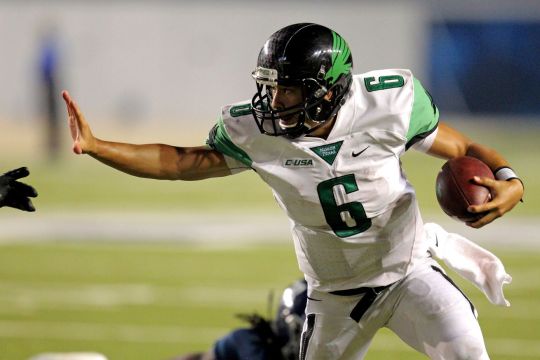
If Seth Littrell can build on what his Mean Green did in year one, Conference USA’s lineup will look even nicer.
This preview originally published March 7 and has since been updated.
You get better by making good hires. That goes for conferences, too. We talk a lot about potential and markets and history and geography and all sorts of factors that go into improving as a group, but the straightest line between where you are and improvement is, simply, hiring good coaches.
Case in point: Here’s a chart of S&P+ averages by conference and year.

Some of the large changes you see are due to conference realignment. The Big East got raided, changed names, and dropped. The Mountain West lost Utah and TCU and dropped. The Pac-12 added Colorado at its most dismal and dropped. Conference USA (and, to a degree, the Mountain West) took on a bunch of start-ups and fixer-uppers and dropped. Et cetera.
That said, a lot of these upward and downward trends have to do with the coaches walking in and out the door.
The Sun Belt of 2012 boasted Gus Malzahn, Mario Cristobal, and Willie Taggart, plus the peaking Todd Berry and Mark Hudspeth.
The surging Pac-12 of 2013 included new additions Rich Rodriguez, Todd Graham, Jim Mora, and Mike Leach.
The drastically improved ACC of 2013 had recently added Larry Fedora and Paul Chryst and featured two elite coaches (Dabo Swinney, Jimbo Fisher) coming into their own. By 2016, the league added coaches like Bobby Petrino, Mark Richt, and Pat Narduzzi and surged even further.
Conference USA has been pretty dismal for a few seasons now. It rose in 2014, but that was primarily due to a surge by Marshall. After peaking at an average S&P+ rating of minus-3.3 in 2008 and nearly matching that in 2011, the conference has been demonstrably worse.
There could be a surge coming, though. And if it happens, hires are predictably the reason. Two have earned quite a bit of recent attention: Butch Davis at FIU and Lane Kiffin at FAU. This duo could drastically change recruiting within the state of Florida and beyond.
But if this rise occurs, it began last year when UTSA brought in Frank Wilson and North Texas hired Seth Littrell.
Wilson got headlines with his recruiting ability and his LSU ties. But the job Littrell did in restoring respectability in Denton was also fantastic.
UNT wasn't an amazing team in 2016. But the story is just how bad the Mean Green were in 2015, Dan McCarney's last year. In just two years, UNT fell from 9-4 and 39th in S&P+ to 1-11 and 128th. The 2015 Mean Green upset UTSA and lost their other 11 contests by an average score of 43-14. They scored more than 24 points just twice; they allowed fewer than 24 points just twice.
This was a miserable, identity-free team. And while Littrell cut his teeth on the offensive side (he spent time as coordinator at Arizona and Indiana), UNT improved on both sides of the ball -- their S&P+ rating (presented as an adjusted points per game average) improved by 6.6 points on offense and 6.2 on defense. Hell, special teams improved by 1.7 points as well.
This was significant improvement for one's first year. Granted, North Texas won just five games and squeezed into a bowl on a technicality, but ... that's still a four-win improvement.
It could just be that UNT was artificially, unsustainably bad in 2015. McCarney’s collapse was sudden, and maybe the Mean Green would have improved even with McCarney in 2016. But when this across-the-board level of improvement takes place under your watch, you get the benefit of the doubt for a while. And when you return most of the reasons for that improvement, you suddenly find yourself facing some expectations.
2016 in review
2016 North Texas statistical profile.
The impressive part was that the Mean Green were competitive at all. But for about half a season, they were more than that.
First 7 games (4-3) — Avg. percentile performance: 40% (~top 75) | Yards per play: Opp 5.5, UNT 4.9 (-0.6) | Avg. performance vs. S&P+ projection: plus-9.7 PPG
Last 6 games (1-5) — Avg. percentile performance: 26% (~top 95) | Yards per play: Opp 6.8, UNT 5.3 (-1.5) | Avg. performance vs. S&P+ projection: minus-11.3 PPG
The offense began to show some life as the year unfolded, while the defense gave out. Still, the early run of decent play, combined with iffy competition, meant that the Mean Green were at .500 heading into November. And though they finished with losses in three of four games and fell to 5-7 overall, their high APR score — a parting gift from McCarney — earned them a spot in the Heart of Dallas Bowl, where they made a late comeback against Army before falling in overtime.
The defense may have faded, but it drove UNT’s wins. The Mean Green allowed only 23 points per game in their wins and played at a 40th percentile level or higher nine times. That isn't the highest bar, but the offense only hit that level six times.
We’ll see how much this shifts in 2017; the offense returns a bit more than the defense does.
Offense
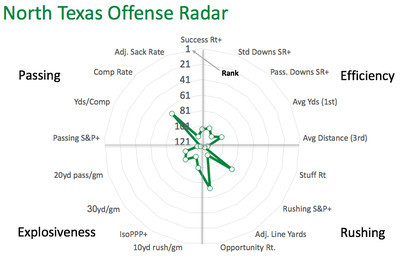
Full advanced stats glossary.
It made sense that Graham Harrell's first season as UNT coordinator was a struggle. He and Littrell took over a unit that not only ranked 123rd in Off. S&P+ the year before, but also did none of the things that they want their offense to do.
Both Harrell and Littrell have air raid ties. Littrell was at Oklahoma when Bob Stoops brought Mike Leach to town, and he served four years as Leach's running backs coach and later spending two years under former Oklahoma coordinator Kevin Wilson. Harrell played for Leach (he was quarterback when Littrell was RBs coach) and spent 2014-15 coaching Leach's outside receivers.
Everybody brings their own influences and intentions, but safe to say both Littrell and Harrell want to be able to wing the ball around. And the offense they inherited ranked last in FBS in Passing S&P+. This was a run-first offense that couldn't throw and moved slowly. Switching to a pass-first attack was going to take a while.
There were bursts of improvement. After gaining just 53 total yards (!) against Florida, North Texas scored 42 points against Rice, 38 against Marshall, and 35 against Army. And after a lull, they averaged a not-awful 28 points per game over their final three contests.
Still, the passing game never really clicked, and UNT improved to only 122nd in Passing S&P+. In a pass-first attack, that's a bit of an issue. But that's what happens when you not only install a new attack, but also put a freshman in charge of it.
Mason Fine took his lumps. Just a few months after Senior Prom in Locust Grove, Okla., Fine was attempting 22 passes (and completing only six) against the vaunted Florida defense. He had relative highs (723 yards, three touchdowns, and no interceptions against Rice, MTSU, and Marshall) and lows, he took 36 sacks, and he suffered an injured shoulder and ceded the floor to Alabama transfer Alec Morris.
Morris is gone, so this is probably Fine's show in 2017. He managed a low interception rate during his 2016 travails, and he's no longer a freshman. He's got an experienced line that boasts honorable mention all-conference left tackle Jordan Murray and six others with starting experience. And in senior running back Jeffery Wilson (5.5 yards per carry plus 29 receptions), he's got a versatile weapon. [Update: FCS backup Loren Easly has transferred from Stephen F. Austin. Also coming up: JUCO OL Sosaia Mose.]
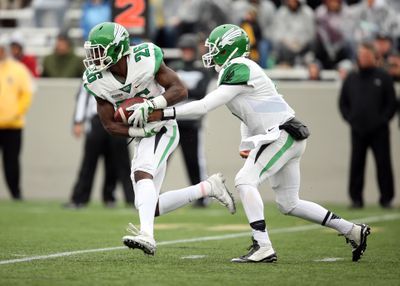
Danny Wild-USA TODAY Sports
Mason Fine & Jeffrey Wilson
What we don't yet know is whether he's got any receivers. Only one (Thaddeous Thompson) managed a 50 percent success rate or 12.5 yards per catch in 2016, and he's gone. In all, UNT quarterbacks targeted eight players more than 15 times last year, and only three return. Having a little experience at QB is a good thing, but it's mitigated if that passer doesn't know his receivers.
After losing Thompson and Kenny Buyers, UNT will need to break in a new set of inside receivers. But there's potential. Sophomore Tyler Wilson fits the slot receiver mold perfectly, as do redshirt freshan Deion Hair-Griffin and incoming three-stars Tre Siggers and Jaelon Darden. Siggers' senior highlight film is particularly exciting — he combines quickness and speed with a streak of brazenness.
If the inside guys are providing decent efficiency, the outside guys could be alright. Senior Turner Smiley came on late in 2016 (last three games: 20 catches, 266 yards), and there could be a reliable contributor among the trio of junior O'Keeron Rutherford and sophomores Rico Bussey Jr. and Kelvin Smith. Meanwhile, three-star JUCO Jalen Guyton, maybe the star of Littrell’s 2017 signing class, is making an impact in spring ball.
Still, with this much turnover in the receiving corps, you can't set the bar for improvement high. Steady play from Wilson will be key to this offense's progress.
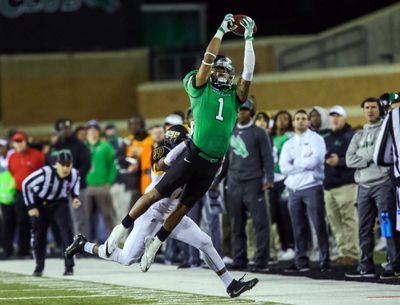
Sean Pokorny-USA TODAY Sports
Turner Smiley
Defense
First things first: kudos to North Texas for creating stats that made its defensive radar look like its logo. Tough to do.

For co-coordinators Troy Reffett and Mike Ekeler (who has departed for UNC, leaving Reffett as solo coordinator), the first year was a bit more successful than Harrell's. The Mean Green boasted an aggressive, efficient defense that rendered opponents one-dimensional, especially later in the year, and if you couldn't run, then you were going to struggle.
If you could run, then you weren't going to find much resistance. Still, UNT improved from 120th to 93rd in Def. S&P+. It's hard to ask for too much more than that out of the gates.
We'll go with the bad news first: there's no immediate reason to believe that the run defense will be better. UNT still ranked 110th in Rushing S&P+ and must now replace four of its top seven tacklers on the line, along with the top two linebackers. Granted, losing contributors from something bad doesn't automatically make things worse, but it doesn't make it better either.

Sean Pokorny-USA TODAY Sports
Joshua Wheeler
There are some play-makers back, at least. Junior Brandon Garner and senior Joshua Wheeler combined for 13.5 tackles for loss and nine sacks last year, and the nose tackle duo of Roderick Young and T.J. Tauaalo was disruptive at times. Still, the run defense faces the burden of proof.
The weakness might not get stronger, but the strength might not get weaker, either. UNT must replace safety James Gray and corner Chad Davis in the secondary, but eight of the top 10 tacklers return. That includes senior safety Kishawn McClain (UNT's leading tackler, who combined five tackles for loss with six passes defensed), corners Nate Brooks and Eric Jenkins (combined: 7 interceptions, 14 breakups), and nickel backs Ashton Preston and Dee Baulkman (combined: 10 TFLs).
North Texas doesn't have the heft required to play sturdy run defense. Or at least, if it does, it's not obvious where that heft comes from. But in the speed department, the Mean Green have quite a bit to offer.
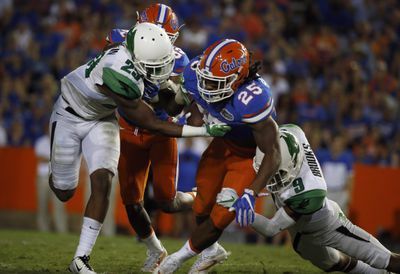
Kim Klement-USA TODAY Sports
Kishawn McClain
Special Teams
Special teams was a strength for UNT. Eric Keena's kickoffs and punts were high and deep, Trevor Moore was automatic inside of 40 yards, and returns were decent.
Good news, bad news: Keena is gone, but Moore and the return men are back. Keena was by far the strongest weapon in the special teams arsenal, but if Moore is still solid, the Mean Green's special teams grade (34th last year) shouldn't drop too far.
2017 outlook
2017 Schedule & Projection Factors
Date Opponent Proj. S&P+ Rk Proj. Margin Win Probability 2-Sep Lamar NR 21.2 89% 9-Sep at SMU 81 -8.7 31% 16-Sep at Iowa 48 -17.9 15% 23-Sep UAB 130 19.6 87% 30-Sep at Southern Miss 84 -7.9 32% 14-Oct UTSA 91 -1.4 47% 21-Oct at Florida Atlantic 99 -4.5 40% 28-Oct Old Dominion 93 -0.9 48% 4-Nov at Louisiana Tech 82 -8.2 32% 11-Nov UTEP 126 8.2 68% 18-Nov Army 102 1.4 53% 25-Nov at Rice 120 0.7 52%
Projected S&P+ Rk 106 Proj. Off. / Def. Rk 113 / 96 Projected wins 5.9 Five-Year S&P+ Rk -9.6 (107) 2- and 5-Year Recruiting Rk 114 / 115 2016 TO Margin / Adj. TO Margin* 1 / -5.1 2016 TO Luck/Game +2.4 Returning Production (Off. / Def.) 66% (63%, 69%) 2016 Second-order wins (difference) 5.2 (-0.2)
North Texas has long been a program with potential. It's proximity to a wealth of recruiting talent was exemplified by the fact that the Mean Green would always turn into a powerhouse back in the early days of EA's NCAA Football. Their promise got the school invited to Conference USA even though, in their last eight years in the Sun Belt, they averaged just 2.8 wins per year.
It's been hard to live up to this promise, at least since the turn-of-the-century glory days under Darrell Dickey. But Littrell's first year at least crystallized what the program could become.
I'm trying hard not to overstate things -- five wins and an S&P+ ranking in the 100s is far from clear proof of concept -- but I've been impressed so far. And if a second year in the system creates offensive growth to pair with another solid pass defense, then a second straight bowl bid seems within reach.
S&P+ projects a six-win season, but there's only one game on the schedule (Week 3 at Iowa) with a win expectancy under 30 percent. Almost every game is winnable or losable, and if North Texas improves again, then that could mean another three- or four-win improvement.
Team preview stats
All preview data to date.
0 notes
Text
North Texas belongs on your list of C-USA teams with promising new coaches
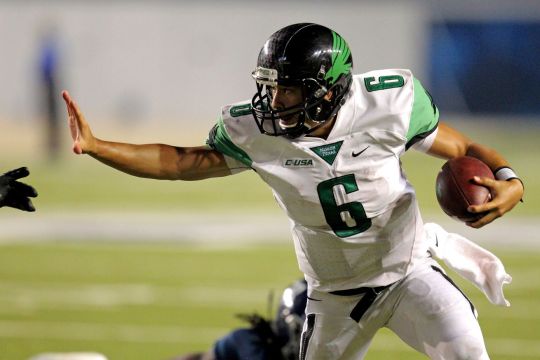
If Seth Littrell can build on what his Mean Green did in year one, Conference USA’s lineup will look even nicer.
You get better by making good hires. That goes for conferences, too. We talk a lot about potential and markets and history and geography and all sorts of factors that go into improving as a group, but the straightest line between where you are and improvement is, simply, hiring good coaches.
Case in point: Here’s a chart of S&P+ averages by conference and year.

Some of the large changes you see are due to conference realignment. The Big East got raided, changed names, and dropped. The Mountain West lost Utah and TCU and dropped. The Pac-12 added Colorado at its most dismal and dropped. Conference USA (and, to a degree, the Mountain West) took on a bunch of start-ups and fixer-uppers and dropped. Et cetera.
That said, a lot of these upward and downward trends have to do with the coaches walking in and out the door.
The Sun Belt of 2012 boasted Gus Malzahn, Mario Cristobal, and Willie Taggart, plus the peaking Todd Berry and Mark Hudspeth.
The surging Pac-12 of 2013 included new additions Rich Rodriguez, Todd Graham, Jim Mora, and Mike Leach.
The drastically improved ACC of 2013 had recently added Larry Fedora and Paul Chryst and featured two elite coaches (Dabo Swinney, Jimbo Fisher) coming into their own. By 2016, the league added coaches like Bobby Petrino, Mark Richt, and Pat Narduzzi and surged even further.
Conference USA has been pretty dismal for a few seasons now. It rose in 2014, but that was primarily due to a surge by Marshall. After peaking at an average S&P+ rating of minus-3.3 in 2008 and nearly matching that in 2011, the conference has been demonstrably worse.
There could be a surge coming, though. And if it happens, hires are predictably the reason. Two have earned quite a bit of recent attention: Butch Davis at FIU and Lane Kiffin at FAU. This duo could drastically change recruiting within the state of Florida and beyond.
But if this rise occurs, it began last year when UTSA brought in Frank Wilson and North Texas hired Seth Littrell.
Wilson got headlines with his recruiting ability and his LSU ties. But the job Littrell did in restoring respectability in Denton was also fantastic.
UNT wasn't an amazing team in 2016. But the story is just how bad the Mean Green were in 2015, Dan McCarney's last year. In just two years, UNT fell from 9-4 and 39th in S&P+ to 1-11 and 128th. The 2015 Mean Green upset UTSA and lost their other 11 contests by an average score of 43-14. They scored more than 24 points just twice; they allowed fewer than 24 points just twice.
This was a miserable, identity-free team. And while Littrell cut his teeth on the offensive side (he spent time as coordinator at Arizona and Indiana), UNT improved on both sides of the ball -- their S&P+ rating (presented as an adjusted points per game average) improved by 6.6 points on offense and 6.2 on defense. Hell, special teams improved by 1.7 points as well.
This was significant improvement for one's first year. Granted, North Texas won just five games and squeezed into a bowl on a technicality, but ... that's still a four-win improvement.
It could just be that UNT was artificially, unsustainably bad in 2015. McCarney’s collapse was sudden, and maybe the Mean Green would have improved even with McCarney in 2016. But when this across-the-board level of improvement takes place under your watch, you get the benefit of the doubt for a while. And when you return most of the reasons for that improvement, you suddenly find yourself facing some expectations.
2016 in review
2016 North Texas statistical profile.
The impressive part was that the Mean Green were competitive at all. But for about half a season, they were more than that.
First 7 games (4-3) — Avg. percentile performance: 40% (~top 75) | Yards per play: Opp 5.5, UNT 4.9 (-0.6) | Avg. performance vs. S&P+ projection: plus-9.7 PPG
Last 6 games (1-5) — Avg. percentile performance: 26% (~top 95) | Yards per play: Opp 6.8, UNT 5.3 (-1.5) | Avg. performance vs. S&P+ projection: minus-11.3 PPG
The offense began to show some life as the year unfolded, while the defense gave out. Still, the early run of decent play, combined with iffy competition, meant that the Mean Green were at .500 heading into November. And though they finished with losses in three of four games and fell to 5-7 overall, their high APR score — a parting gift from McCarney — earned them a spot in the Heart of Dallas Bowl, where they made a late comeback against Army before falling in overtime.
The defense may have faded, but it drove UNT’s wins. The Mean Green allowed only 23 points per game in their wins and played at a 40th percentile level or higher nine times. That isn't the highest bar, but the offense only hit that level six times.
We’ll see how much this shifts in 2017; the offense returns a bit more than the defense does.
Offense
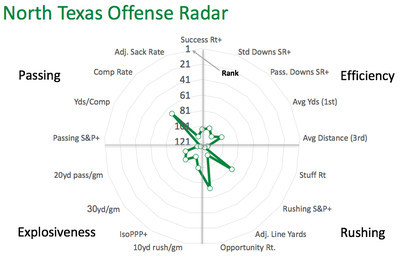
Full advanced stats glossary.
It made sense that Graham Harrell's first season as UNT coordinator was a struggle. He and Littrell took over a unit that not only ranked 123rd in Off. S&P+ the year before, but also did none of the things that they want their offense to do.
Both Harrell and Littrell have air raid ties. Littrell was at Oklahoma when Bob Stoops brought Mike Leach to town, and he served four years as Leach's running backs coach and later spending two years under former Oklahoma coordinator Kevin Wilson. Harrell played for Leach (he was quarterback when Littrell was RBs coach) and spent 2014-15 coaching Leach's outside receivers.
Everybody brings their own influences and intentions, but safe to say both Littrell and Harrell want to be able to wing the ball around. And the offense they inherited ranked last in FBS in Passing S&P+. This was a run-first offense that couldn't throw and moved slowly. Switching to a pass-first attack was going to take a while.
There were bursts of improvement. After gaining just 53 total yards (!) against Florida, North Texas scored 42 points against Rice, 38 against Marshall, and 35 against Army. And after a lull, they averaged a not-awful 28 points per game over their final three contests.
Still, the passing game never really clicked, and UNT improved to only 122nd in Passing S&P+. In a pass-first attack, that's a bit of an issue. But that's what happens when you not only install a new attack, but also put a freshman in charge of it.
Mason Fine took his lumps. Just a few months after Senior Prom in Locust Grove, Okla., Fine was attempting 22 passes (and completing only six) against the vaunted Florida defense. He had relative highs (723 yards, three touchdowns, and no interceptions against Rice, MTSU, and Marshall) and lows, he took 36 sacks, and he suffered an injured shoulder and ceded the floor to Alabama transfer Alec Morris.
Morris is gone, so this is probably Fine's show in 2017. He managed a low interception rate during his 2016 travails, and he's no longer a freshman. He's got an experienced line that boasts honorable mention all-conference left tackle Jordan Murray and six others with starting experience. And in senior running back Jeffery Wilson (5.5 yards per carry plus 29 receptions), he's got a versatile weapon.
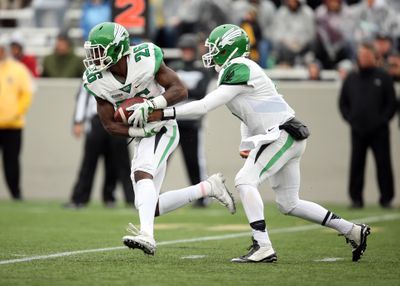
Danny Wild-USA TODAY Sports
Mason Fine & Jeffrey Wilson
What we don't yet know is whether he's got any receivers. Only one (Thaddeous Thompson) managed a 50 percent success rate or 12.5 yards per catch in 2016, and he's gone. In all, UNT quarterbacks targeted eight players more than 15 times last year, and only three return. Having a little experience at QB is a good thing, but it's mitigated if that passer doesn't know his receivers.
After losing Thompson and Kenny Buyers, UNT will need to break in a new set of inside receivers. But there's potential. Sophomore Tyler Wilson fits the slot receiver mold perfectly, as do redshirt freshan Deion Hair-Griffin and incoming three-stars Tre Siggers and Jaelon Darden. Siggers' senior highlight film is particularly exciting — he combines quickness and speed with a streak of brazenness.
If the inside guys are providing decent efficiency, the outside guys could be alright. Senior Turner Smiley came on late in 2016 (last three games: 20 catches, 266 yards), and there could be a reliable contributor among the trio of junior O'Keeron Rutherford and sophomores Rico Bussey Jr. and Kelvin Smith. Meanwhile, three-star JUCO Jalen Guyton, maybe the star of Littrell’s 2017 signing class, is making an impact in spring ball.
Still, with this much turnover in the receiving corps, you can't set the bar for improvement high. Steady play from Wilson will be key to this offense's progress.
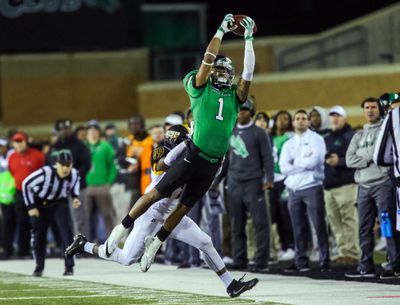
Sean Pokorny-USA TODAY Sports
Turner Smiley
Defense
First things first: kudos to North Texas for creating stats that made its defensive radar look like its logo. Tough to do.
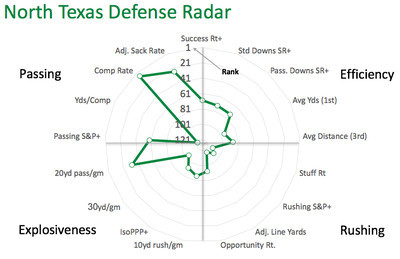
For co-coordinators Troy Reffett and Mike Ekeler (who has departed for UNC, leaving Reffett as solo coordinator), the first year was a bit more successful than Harrell's. The Mean Green boasted an aggressive, efficient defense that rendered opponents one-dimensional, especially later in the year, and if you couldn't run, then you were going to struggle.
If you could run, then you weren't going to find much resistance. Still, UNT improved from 120th to 93rd in Def. S&P+. It's hard to ask for too much more than that out of the gates.
We'll go with the bad news first: there's no immediate reason to believe that the run defense will be better. UNT still ranked 110th in Rushing S&P+ and must now replace four of its top seven tacklers on the line, along with the top two linebackers. Granted, losing contributors from something bad doesn't automatically make things worse, but it doesn't make it better either.
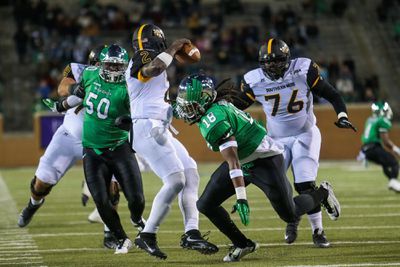
Sean Pokorny-USA TODAY Sports
Joshua Wheeler
There are some play-makers back, at least. Junior Brandon Garner and senior Joshua Wheeler combined for 13.5 tackles for loss and nine sacks last year, and the nose tackle duo of Roderick Young and T.J. Tauaalo was disruptive at times. Still, the run defense faces the burden of proof.
The weakness might not get stronger, but the strength might not get weaker, either. UNT must replace safety James Gray and corner Chad Davis in the secondary, but eight of the top 10 tacklers return. That includes senior safety Kishawn McClain (UNT's leading tackler, who combined five tackles for loss with six passes defensed), corners Nate Brooks and Eric Jenkins (combined: 7 interceptions, 14 breakups), and nickel backs Ashton Preston and Dee Baulkman (combined: 10 TFLs).
North Texas doesn't have the heft required to play sturdy run defense. Or at least, if it does, it's not obvious where that heft comes from. But in the speed department, the Mean Green have quite a bit to offer.
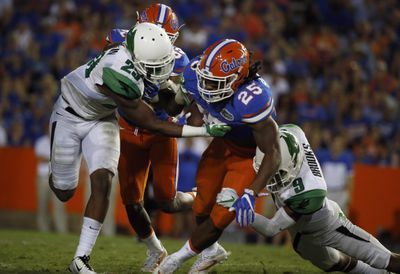
Kim Klement-USA TODAY Sports
Kishawn McClain
Special Teams
Special teams was a strength for UNT. Eric Keena's kickoffs and punts were high and deep, Trevor Moore was automatic inside of 40 yards, and returns were decent.
Good news, bad news: Keena is gone, but Moore and the return men are back. Keena was by far the strongest weapon in the special teams arsenal, but if Moore is still solid, the Mean Green's special teams grade (34th last year) shouldn't drop too far.
2017 outlook
2017 Schedule & Projection Factors
Date Opponent Proj. S&P+ Rk Proj. Margin Win Probability 2-Sep Lamar NR 21.2 89% 9-Sep at SMU 81 -8.7 31% 16-Sep at Iowa 48 -17.9 15% 23-Sep UAB 130 19.6 87% 30-Sep at Southern Miss 84 -7.9 32% 14-Oct UTSA 91 -1.4 47% 21-Oct at Florida Atlantic 99 -4.5 40% 28-Oct Old Dominion 93 -0.9 48% 4-Nov at Louisiana Tech 82 -8.2 32% 11-Nov UTEP 126 8.2 68% 18-Nov Army 102 1.4 53% 25-Nov at Rice 120 0.7 52%
Projected S&P+ Rk 106 Proj. Off. / Def. Rk 113 / 96 Projected wins 5.9 Five-Year S&P+ Rk -9.6 (107) 2- and 5-Year Recruiting Rk 114 / 115 2016 TO Margin / Adj. TO Margin* 1 / -5.1 2016 TO Luck/Game +2.4 Returning Production (Off. / Def.) 66% (63%, 69%) 2016 Second-order wins (difference) 5.2 (-0.2)
North Texas has long been a program with potential. It's proximity to a wealth of recruiting talent was exemplified by the fact that the Mean Green would always turn into a powerhouse back in the early days of EA's NCAA Football. Their promise got the school invited to Conference USA even though, in their last eight years in the Sun Belt, they averaged just 2.8 wins per year.
It's been hard to live up to this promise, at least since the turn-of-the-century glory days under Darrell Dickey. But Littrell's first year at least crystallized what the program could become.
I'm trying hard not to overstate things -- five wins and an S&P+ ranking in the 100s is far from clear proof of concept -- but I've been impressed so far. And if a second year in the system creates offensive growth to pair with another solid pass defense, then a second straight bowl bid seems within reach.
S&P+ projects a six-win season, but there's only one game on the schedule (Week 3 at Iowa) with a win expectancy under 30 percent. Almost every game is winnable or losable, and if North Texas improves again, then that could mean another three- or four-win improvement.
Team preview stats
All preview data to date.
0 notes
Text
Arizona State and Texas A&M fired winning coaches. That backfires all the time.
You usually can’t just fire your way out of Glen Mason Territory.
For a long time in my offseason preview series, I have talked about Glen Mason Territory and what it does to a program. I should probably explain what it is.
In 1997, Minnesota hired Mason to replicate a salvage job he had just pulled at Kansas. The former Ohio State offensive coordinator arrived the year before Bill Snyder at Kansas State and had a job nearly as tough.
Mason never quite pulled off a top-10 finish at Minnesota, but he did what he was asked to do. The Golden Gophers had been to three bowls, with zero ranked finishes, in the 35 years before his arrival. The Big Ten was producing redemption stories left and right — Wisconsin in 1993, Northwestern in 1995, and soon, Purdue in 2000 — and Minnesota was getting left behind.
After winning eight combined games in his first two years, Mason won eight in 1999, pulling a program-defining upset of No. 2 Penn State and reaching 12th in the country before a bowl loss.
The Gophers would bowl again in 2000 and 2002, then surge in 2003. Behind the punishing combination of Marion Barber III and Laurence Maroney, they beat Penn State and Wisconsin on the way to a 9-3 regular season, then Oregon in a Sun Bowl thriller to reach 10 wins for the first time since 1905.
The problem: he never won 10 again. The Gophers started 2004 5-0 and reached 13th before losing five of six down the stretch and needing a bowl win to salvage 7-5. They went 7-5 again in 2005 and were on the doorstep of a third straight seven-win season in 2006 before blowing an enormous Insight Bowl lead to Texas Tech.
A year after a contract extension, Minnesota used the bowl collapse as impetus for panic. Despite seven bowls in eight years — for a program that had been almost absent from college football's consciousness for nearly four decades — the school pushed Mason out.
The program had grown stale, you see, and needed young energy. “I believe the program needs a new vision to reignite fan enthusiasm,” said athletic director Joel Maturi.
So he brought in Tim Brewster, a charismatic NFL position coach and Illinois alum. Brewster was the anti-Mason. He would recruit. He would give the program a shot in the arm. He would prove the Gophers should expect more than bowl bids. He would go 15-30.
Glen Mason Territory comes when your head coach raises the bar but fails to keep raising the bar.
You know it is coming when you see fans, beat writers, or athletic directors use words like "stale" or "raise the bar" or “aspiration” or “potential” or “sleeping giant.” The AD, when addressing the firing with the media, might say something like "We want to be in major bowl games on a consistent basis."
Arizona State and Texas A&M their fired coaches on Sunday after 7-5 seasons.
For A&M’s Kevin Sumlin, the firing might have almost felt freeing. He’s been on or near the hot seat pretty much non-stop since 2015, a victim of his initial success. After going 11-2 and engineering the Aggies’ first top-five finish since 1956 with Johnny Manziel, Sumlin couldn’t take the next step. (That’s a tricky thing to do, since there was only about one step above that one.) He went 8-5 each year from 2014-16 and was on the doorstep of the same this fall.
Mind you, that’s damn good. In a division in which the last-place coach was regularly guaranteed to make $4 million-plus, A&M never finished all that close to last place.
Bret Bielema, engineer of three Rose Bowl bids at Wisconsin, went 4-8 this year at Arkansas. Dan Mullen just upgraded to the Florida job after going 14-11 the last two years at Mississippi State. Sumlin was canned after 15-10 over the same span.
Sumlin’s limitations were established. It even shows up in the most virulent defense I can muster for him.
He went 7-5 with an ultra-young team this year. But he almost always had an ultra-young team.
Photo by Sean Gardner/Getty Images
Kevin Sumlin
A&M fielded two freshman quarterbacks, a sophomore running back, a receiving corps with seven freshmen among the top eight WRs, an injury-plagued offensive line (10 different guys started at least once, and freshmen and sophomores accounted for 26 of 60 starts), and a defense with nine freshmen and sophomores among the 15 leading tacklers. That the Aggies won at Florida and Ole Miss and overcame a devastating early loss to UCLA to win seven games with that is a bit of an accomplishment.
Sumlin would sign top-15 classes, play a bunch of young studs early, then lose a lot of them before they could mature. That was especially true at quarterback, where either a freshman or a sophomore took the majority of snaps in all but one of his years (and the one upperclassman, Trevor Knight in 2016, was a graduate transfer).
Hiring a new coach is a terrifying crap shoot, and I always say that you shouldn’t do it unless you know you can’t fulfill realistic goals with the guy you’ve got.
I don’t think you could say that with certainty about Sumlin and A&M. But you also couldn’t guarantee a surge. A&M hadn’t been able to top 24th in S&P+ since Manziel left. And when you spend money like A&M does — and oh, ho, ho, is A&M willing to spend money — one can understand a lack of patience, even if I remain someone who always stresses patience.
Arizona State, though?
Since peaking under Bruce Snyder in the mid-1990s — the Sun Devils went 11-1 in 1996 and damn near won the national title, then went 9-3 the next year as well — ASU has proved capable of brief, high ceilings.
Snyder won just 17 games from 1998-2000 and was replaced by Dirk Koetter, who helped to build the Boise State machine and went 9-3 in 2004 but otherwise averaged 6.2 wins per year. He was let go after back-to-back seven-win seasons and replaced by Dennis Erickson, who stormed out with an 8-0 start, then 23-31 from then on.
Todd Graham came to Tempe in 2012 and immediately established a higher level. ASU improved from 6-7 to 8-5 in his first year, 10-4 and won the Pac-12 South in 2013, and won 10 games again in 2014, finishing 12th in the AP poll (their highest finish since 1996).
With success came turnover. Graham has long been one of the best hirers in the game — he hired Auburn's Gus Malzahn and SMU's Chad Morris at Tulsa, and longtime protege Mike Norvell is 18-6 in two years at Memphis. After losing Norvell, he lost his next offensive coordinator, Chip Lindsey, to Malzahn.
Photo by Christian Petersen/Getty Images
He had to replace difference-makers on the field and on the sideline and went 11-14 in 2015-16. After a 2-3 start in 2017, Graham's Sun Devils won five of their last seven, knocking off No. 5 Washington in October and finishing with a 12-point win over rival Arizona.
They went 7-5 with an exciting, underclassman quarterback and a young receiving corps. That's the kind of run that saves your job. Only, ASU fired Graham.
ASU athletic director Ray Anderson gave one hell of a performance in his post-Graham press conference on Sunday. He announced:
He wasn't okay with minor bowl bids.
ASU didn't have "competitive consistency" (even though ASU hasn't had "competitive consistency" since the Frank Kush years in the 1970s).
He wasn't happy that ASU had only one draft pick in 2017.
He wants Graham's replacement to consider keeping both of Graham's coordinators, Billy Napier and Phil Bennett, noting that star QB Manny Wilkins "does not need a fourth coordinator in four years."
Those who think he's setting the bar too high are "misguided, they are living in the past."
Basically, he wants to keep all of the good Graham things but change all of the bad Graham things.
Maybe Anderson has someone in mind. Per one early rumor, it might even be Sumlin. Napier’s offensive vision isn’t that far from his, and if Sumlin can upgrade recruiting, maybe he’s the man to take advantage of a Pac-12 South in transition. He’s a good coach.
Or maybe he’ll win eight games a year, and Anderson will tire of that just like A&M did.
Georgia fired Mark Richt despite 50 wins in his last five seasons in charge. After a one-year reset, Kirby Smart has the Dawgs 11-1 and a game away from a likely College Football Playoff bid. We have no idea about Smart's program maintenance abilities, but safe to say, the Dawgs have gotten what they hoped for early on.
They're also Georgia, a heavyweight in a state loaded with blue-chippers.
For schools with lesser advantages, impatience almost never pays off.
On the heels of 11- and nine-win seasons, Boston College pushed Jeff Jagodzinski out because he deigned to interview for other jobs. They were 2-10 four years later and haven’t reached nine wins since.
Ron Zook took Illinois to nine wins and a Rose Bowl in 2007, and after a two-year reset, got them back to 7-6 in both 2010 and 2011. He was fired. Illinois has averaged 3.7 wins per year since.
Dan McCarney won at least seven games five times in a six-year span at Iowa State but was let go after a 4-8 downturn in 2006. ISU has not topped seven wins since, though that could change with an upcoming bowl game.
Ralph Friedgen took Maryland to seven bowls in 10 years, and after a two-win collapse in 2009, rebounded to nine wins in 2010. Maryland has averaged 4.7 wins per year since firing him.
NC State pushed Tom O'Brien out in 2012 after 24 wins in three years. Their best three-year win total since: 22.
David Cutcliffe won seven or more games for five straight years at Ole Miss, peaking with a 10-win campaign in 2003. But after a 4-7 reset in 2004, he was fired. The Rebels would top four wins twice in the next seven years.
Pitt pushed Dave Wannstedt out after after 26 wins in three years. The Panthers have averaged 6.6 wins since.
Despite seven ranked finishes in 11 years, Syracuse fired Paul Pasqualoni after he hit a dry spell. He went 4-8 in 2002 then rebounded to only 6-6 in 2003-04. Syracuse went 10-37 under replacement Greg Robinson and has averaged 4.4 wins since Pasqualoni.
Phil Fulmer took Tennessee to 15 bowls and five SEC championship games in 16 years. He won the national title in 1998 and won at least eight games 14 times. He fell to 5-6 in 2005 but rebounded back to 10 wins in 2007. After a second five-win reset in 2008, he was fired. The Vols have hit the eight-win mark twice in the nine years since.
When you find yourself stuck with a coach who is good but not good enough, the problem often isn’t him.
It’s infrastructure. It’s history. It’s program support. It’s something other than the head coach. But the head coach is the easiest thing to change, so schools follow the same fruitless road over and over and over again.
Maybe Arizona and/or Texas A&M turn out to be the exceptions. But you can almost never fire your way out of Glen Mason Territory, no matter how good it feels to try.
0 notes